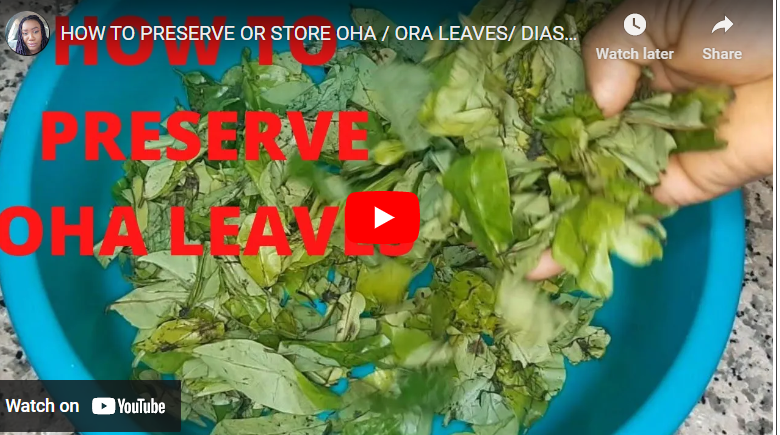Nigerian cuisine is known for its rich flavors and diverse ingredients, and one ingredient that stands out is Oha leaves. These leaves are commonly used in traditional Nigerian soups and stews, and are highly valued for their nutritional benefits.
However, because they are not readily available outside of Nigeria, preserving them is crucial to ensure that they can be enjoyed year-round.
Preserving oha leaves for long time storage is easy! Start by washing the leaves and drying them in the sun until they are crisp. Next, spread the leaves out on a clean surface and sprinkle them with a generous amount of salt. Allow the leaves to sit in the salt for several hours before transferring them to an airtight container. Store the container in a cool, dry place and the leaves should stay fresh for up to a year.
How To Preserve Oha Leaves
If you’re a fan of traditional Nigerian cuisine, then you’re probably familiar with Oha leaves. These leaves are a key ingredient in many soups and stews, and are prized for their rich flavor and nutritional value.
However, because they’re not readily available outside of Nigeria, it’s important to know how to preserve them.
Read Also: How to Preserve Ogbono For Long Storage
By drying or freezing them properly, you can ensure that you always have fresh Oha leaves on hand to add to your favorite recipes.
Freezing Method
If you’re interested in preserving Oha leaves by freezing them, here is a step-by-step guide to help you get started:
- Wash the Oha leaves thoroughly to remove any dirt or debris.
- Blanch the leaves by immersing them in boiling water for about 2-3 minutes, then immediately transferring them to a bowl of ice water to stop the cooking process. This will help to preserve their color and flavor.
- Drain the leaves well and place them in a single layer on a baking sheet lined with parchment paper. The purpose of this is to avoid their cohesion while they undergo the freezing process.
- Place the baking sheet in the freezer and freeze until the leaves are completely frozen.
- Once frozen, transfer the leaves to an airtight container or freezer bag. Be sure to remove as much air as possible before sealing the container or bag.
- Label the container or bag with the date and contents, and place it in the freezer.
Read Also: How To Preserve Green Peppers For Long Time Storage
By following these simple steps, you can preserve Oha leaves for up to six months in the freezer. When you’re ready to use them, simply remove the desired amount from the freezer and thaw them in the refrigerator or at room temperature before adding them to your recipe.
Drying Method
If you’re interested in preserving Oha leaves by drying them, here is a step-by-step guide to help you get started:
Read Also: How To Preserve Okra For Long Time Storage
- Wash the Oha leaves thoroughly to remove any dirt or debris.
- Shake off any excess water, and then spread the leaves out in a single layer on a clean, dry surface. You can use a drying rack, clean towel, or even a clean countertop.
- Place the leaves in a sunny spot or in a warm, dry area with good air circulation. You can also dry them in an oven set to the lowest temperature setting.
- Allow the leaves to dry completely, which can take anywhere from a few hours to a few days depending on the weather and drying method.
- Once the leaves are completely dry and brittle, remove any stems or veins and crush them into small pieces. Alternatively, you can leave the leaves whole if you prefer.
- Store the dried leaves in an airtight container or plastic bag, and be sure to label the container with the date and contents.
Read Also: How To Preserve Kiwi For Long Time Storage
By following these simple steps, you can preserve Oha leaves for several months using the drying method. When you’re ready to use them, simply rehydrate the desired amount by soaking them in water for a few minutes before adding them to your recipe.
Important to Preserve Oha Leaves
If you’re wondering why it’s so important to preserve Oha leaves, there are a few key reasons.
First and foremost, Oha leaves are incredibly nutritious and contain a wide range of vitamins and minerals that are essential for maintaining good health.
They’re also a staple ingredient in many traditional Nigerian dishes, so being able to preserve them allows you to enjoy these delicious recipes year-round, regardless of where you live.
Read Also: How To Preserve Locust Beans For Long Time Storage
Additionally, because Oha leaves aren’t readily available outside of Nigeria, knowing how to preserve them ensures that you always have a supply on hand for whenever you want to cook up something delicious.
How to use preserved Oha leaves
Now that you know how to preserve Oha leaves, you may be wondering how to use them in your cooking. Fortunately, preserved Oha leaves can be used in a variety of ways, and are a versatile ingredient that can add flavor and nutrition to many different dishes.
One popular way to use preserved Oha leaves is in soups and stews. Simply rehydrate the leaves by soaking them in water for a few minutes, then add them to your pot of simmering soup or stew. They’ll impart a rich, earthy flavor to the dish and add a boost of vitamins and minerals.
Read Also: How To Preserve Green Peas For Long Time Storage
Preserved Oha leaves can also be used in stir-fries, omelets, and even salads. Chopped up and added to a simple salad with a light dressing, they’ll add a unique flavor and texture that’s sure to impress.
If you’re looking for specific recipe ideas, there are many traditional Nigerian dishes that call for Oha leaves, such as Oha soup and Egusi soup. These dishes typically include a variety of other ingredients such as meat, fish, or vegetables, and are a great way to showcase the flavor and versatility of preserved Oha leaves.
Factors that affect Oha Leaves Preservation
Here are some of the factors that are likely to affect oha leaves preservation. They include:
1. Temperature
Temperature is one of the most important factors that affects the preservation of oha leaves. If the temperature is too high or too low, the leaves will begin to deteriorate. Keeping the leaves in a cool and dry place will help to preserve them for a longer time.
Read Also: How to Preserve Irish Potatoes For Long Time Storage
2. Moisture
High levels of moisture can cause the leaves to become soft and limp, making them prone to mold and decay. Keeping the leaves in an area with low humidity will help to preserve them.
3. Light
Exposure to direct sunlight can cause the leaves to fade or become discolored. It is important to keep the leaves in a dark and cool place.
4. Air
Oxygen is important for the preservation of oha leaves. However, too much oxygen can lead to the leaves becoming dry and brittle. Storing the leaves in an airtight container can help to prevent this from occurring.
Read Also: How To Preserve Jackfruit For Long Time Storage
5. Pests
Pests such as insects, rodents, and other animals can cause significant damage to oha leaves. To protect the leaves, it is important to keep them away from these pests.
Advantages of Oha Leaves Preservation
- Oha leaf preservation helps to reduce waste and conserve resources. As the leaves are dried and stored in a cool and dry place, they can be used for a longer period of time than fresh leaves.
- Oha leaf preservation helps to preserve the nutrients present in the leaves. The drying process helps to retain most of the essential vitamins and minerals present in the leaves, which can be beneficial for our health.
- Oha leaf preservation is a cost-effective method of food storage. As the leaves are dried and stored for a longer period of time, it saves on the costs of buying fresh oha leaves regularly.
- Oha leaf preservation helps to reduce food-borne illnesses. As the leaves are dried and stored in a hygienic environment, it reduces the risk of food contamination and food-borne illnesses.
- Oha leaf preservation helps to enhance the flavor and texture of the leaves. The drying process helps to bring out the flavor of the leaves, which can make them more appetizing and enjoyable to eat.
Read Also: How To Preserve Lettuce For long Time Storage
Disadvantages of Oha Leaves Preservation
- Oha leaf preservation may cause a loss of nutrients in the leaves. The drying process can cause some of the essential vitamins and minerals to be lost, which can reduce the nutritional value of the leaves.
- Oha leaf preservation can cause the leaves to become brittle and fragile. As the leaves are dried and stored for a longer period of time, they become brittle and fragile, which can make them difficult to use.
- Oha leaf preservation can lead to an unpleasant taste and smell. As the leaves are dried, they can become musty and develop an unpleasant smell and taste, which can make them unappetizing.
- Oha leaf preservation can be time-consuming. The drying process can take several days, which can be inconvenient if you need to use the leaves quickly.
- Oha leaf preservation can be costly. As the leaves need to be dried and stored in a cool and dry place, it can be expensive to buy the necessary equipment and supplies for the preservation process.
Read Also: How To Preserve Green Beans For Long Time Storage
Best Practices for Oha Leaves Preservation
- Ensure that the leaves are properly dried and stored in airtight containers. This will help to keep the leaves from becoming moldy and help to preserve their freshness.
- Make sure to store the leaves in a cool and dry environment, away from direct sunlight or heat.
- Keep the oha leaves away from moisture, as this can cause the leaves to spoil.
- If possible, store the oha leaves in a refrigerator or freezer. This will help to extend the shelf life of the leaves.
- Do not keep the leaves for too long, as they can become bitter and lose their flavor over time.
- When preparing the leaves for cooking, use fresh leaves whenever possible.
- Avoid using too much heat when cooking the leaves, as this can reduce their flavor and nutritional content.
- Add the oha leaves to dishes just before serving, as prolonged cooking can reduce the flavor and nutritional value of the leaves.
Read Also: How To Preserve Lemon For Long Time Storage
Conclusion
To conclude, Oha leaves are a traditional and versatile ingredient used in many Nigerian dishes. It is important to preserve them in order to use them in the future and to ensure they remain fresh and flavorful. By following the simple steps outlined above, you can properly store and preserve Oha leaves for long-term use.




